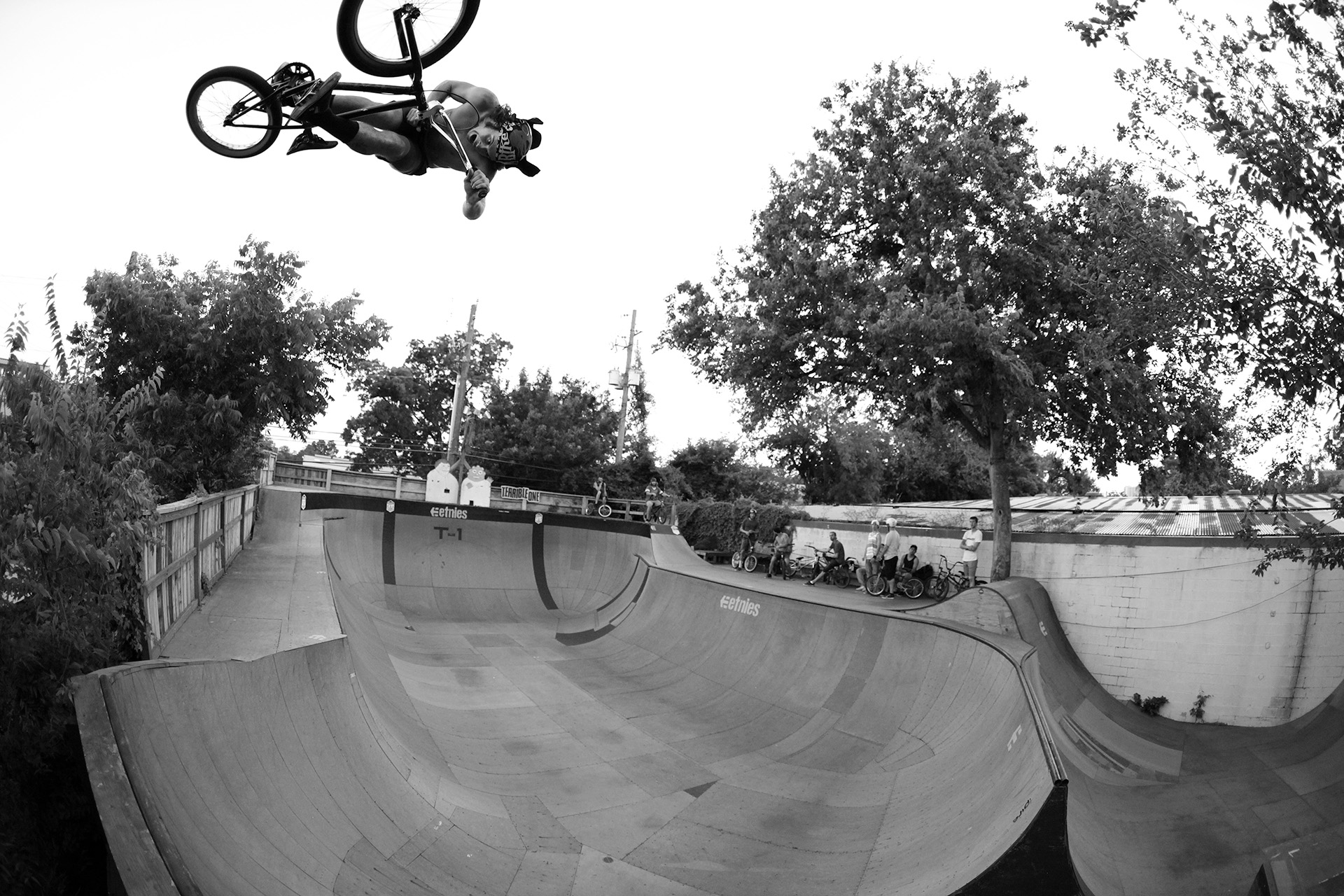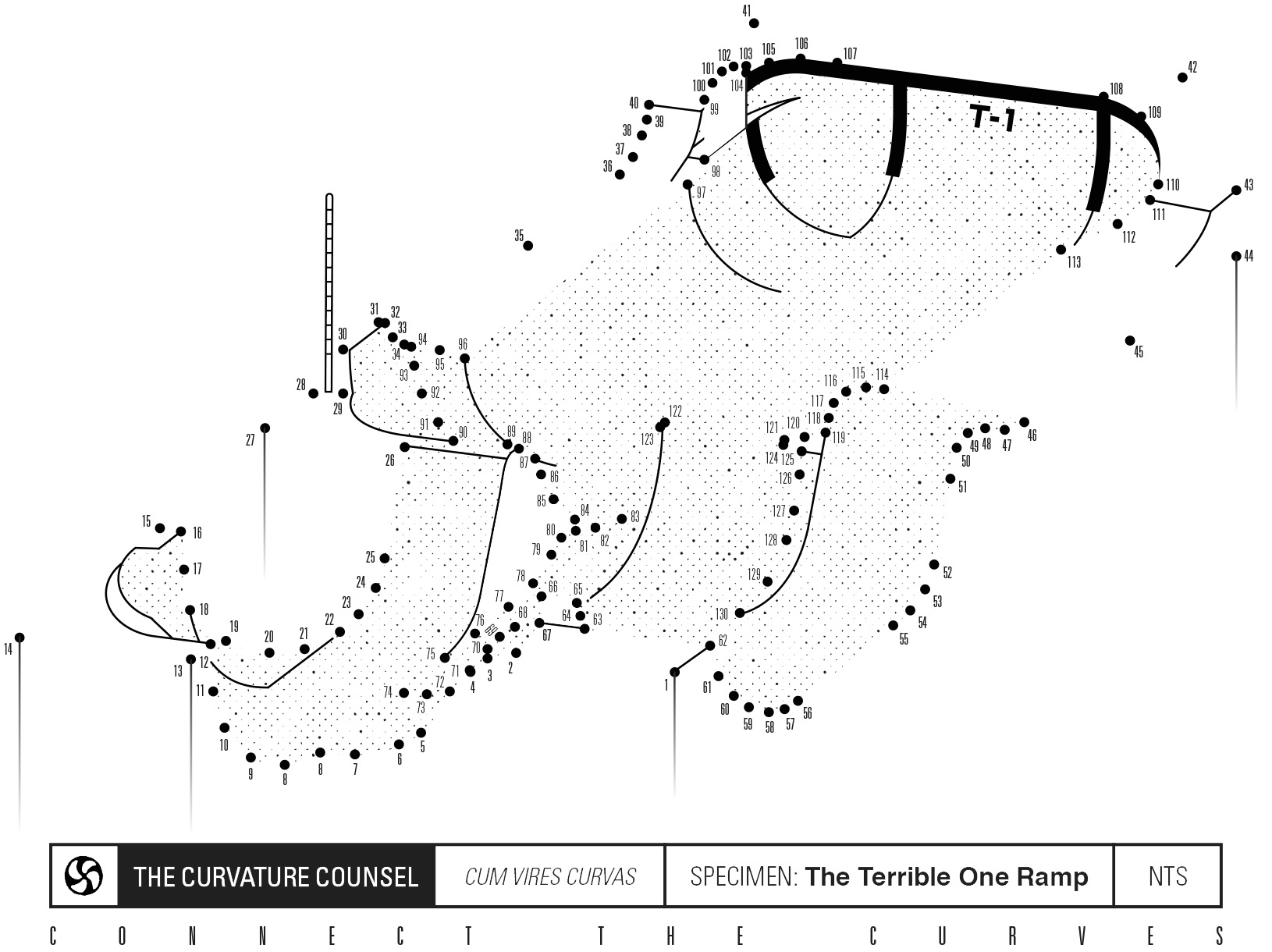Curvature Counsel: The T1 Ramp
by Chester JonesMatt Aquizap by Joe Rich
In the world of backyard setups, The Terrible One ramp sat as one of the ultimate shredding spaces of the past and present decade. An ever illustrious and inspiring curvature of seamless imaginative wonder from Ryan Corrigan and the T1 family.
Since the patina’d plywoods passing, The Curvature Counsel shot Joe Rich a few inquiries on the enigma of transcendental transitions; The Temple of Roast.
Challenger:
Since it's been several years now since you dismantled the ramp, how do you look back at the time when the ramp was running? What stands out most when you reminisce?
Joe Rich:
The main feeling that runs through me is just pure stoke that we did it. From the first day that we got the key to that building, we went and bought wood before we moved anything else into the office. Haha. Just taking an empty space and converting it into a dream, step by step...
And from the very beginning, it was always in the cards that it would come down. We just didn’t know if it was going to be because of the landlord, the city, or something else. It became something I never could have imagined, and I just feel grateful in the end. So many good times riding, building, and just hanging out. Not bummed one bit, just a warm feeling inside is all that exists.
Challenger:
Before the T1 ramp did you ever have any other backyard ramps growing up?
Joe Rich:
Yeah, for sure. My brother skateboarded and we had this 6ft tall, 8ft wide half pipe that went to vert! It was in my driveway when I was 11 or 12. After that came down, we built some smaller quarter pipes out of the wood. That was all before I actually bought my first proper BMX bike. But a couple of years later, I was riding all the time, so my dad and I built an 8ft tall, 12 ft wide quarter that was really good. I lived on a corner that was on a hill. So you would just bomb down the road that was downhill, around the corner and there it was...blast off!
And it’s in the details that can take something from being good, to really incredible.
Challenger:
Ryan Corrigan and yourself disagreed by one inch on the radius for the 9ft blaster quarter right? It seems like you’re splitting hairs there! I’m interested in hearing the process behind that. Was there a quarter somewhere that influenced the roaster on the ramp?
Joe Rich:
Haha, yeah, we both had our ideas of what 9.5ft addition should be when we built it. I don’t even remember what led us to wanting it being 9.5ft tall, but we both agreed on it. And it was only 1 inch difference between transition size and how much vert would be on it. But we actually did discuss that 1 inch for quite a bit. Hahaha. In the end, we went with Ryan’s call on it. I think that part of it is fun. And it’s in the details that can take something from being good, to really incredible. The fine tuning of an idea might be one of my favorite past times.
Challenger:
What was your favourite part of the ramp?
Joe Rich:
I never had a single favorite part. Maybe on a certain day I did, but that changed all the time. When I think about the ramp, my first thoughts of it are always as a whole. Both in its physical sense, and how it just felt to be back there. There was just so many different lines, and combinations of feelings that happened as a result of it. So I could never pick just one.
Challenger:
Ripping the bowl corners was one of your favorite things to do on the ramp. Do you mind revealing any tips on how-to properly carve a corner?
Joe Rich:
Drop that inside shoulder, and hang on!
Challenger:
In a parallel universe, what would you think if you came upon the same exact ramp but constructed out of concrete? Additionally, let’s hear your take on riding wood vs. concrete?
Joe Rich:
Hmmmmm, that’s hard to say. Because there is a certain flex to wood that almost makes the transition change as you ride it. You don’t get that with concrete and I think that’s why you can have a concrete quarter with the same transitions as a wooden ramp, and it’ll feel completely different. When you pump the shit out of something, that flex, or no flex, is something you get used to. So even if the same transition was made out of a different material, it would feel a lot different. And that feel can vary even further by the wood the ramp is built with. 2x4’s vs 2x6’s, 1 layer of ply, 2 layers of ply, 2 layers of ply with Skatelite...and so forth. It all dramatically affects the feel. So the term “wooden ramp” can be very vague. ha ha ha. Once again, what makes something that really stands out is in the details of it. I don’t know how to fully describe it, but I could prefer to ride either one just the same depending on the design of it.
Challenger:
The ramp had a huge influence on the mid-school to present day era, looking back; what was the biggest impact it made for you and T1 as a brand?
Joe Rich:
I love how many people it brought together. Through all the years and all of the different scenarios that brought so many to our backyard. Everything from large amounts of people that would show up for a jam, benefit, or premiere. To the days when I’d get a knock on the door and someone would be there by themselves. It was really great to be able to share that with so many people from all over. Growing up, I remember thinking about places like the Enchanted Ramp that Ron Wilkerson had. I thought that must be the best place on earth when I’d stare at the posters on my wall of it. And it was hard for me to understand at first that our ramp could have been that for someone. I’d meet people that would just have this exhale of pure joy when I’d lead them back to the ramp, and they’d say: “I’ve been wanting to come here for 10 years.” That was always such a cool experience.
Challenger:
The ramp was very utilitarian and linear at first, and then the space became very imaginative and experimental. Was there ever construction drawings for parts of the ramp between you and Ryan, or was it just purely freestyled?
Joe Rich:
When we first built it, we just wanted something to ride that we really liked. The first phase of it was inspired by a ramp that was way up north of Austin at the Ramp Ranch indoor skatepark. We were driving there 3 or 4 nights a week, and that was what we rode the most. So it was a natural thought to build something based on that ramp when we got the new place in 2002. We added, and changed a few things about it, and created our own version. That first phase remained as it was built for about 10 months. And that’s when Taj really set it off by bringing about the idea to bowl in the one end. So Ryan and Paul B. (Buchanan) went to work and created one huge speed machine complete with plenty of vert, some not so normal angles, and a hip as well. It was so unique, and that addition changed everything! From there, it almost started designing itself by the ways it gave you speed and the angles that it spit you out at. We just followed the signs it was giving us, and made sure we put something in those areas that could hold the speed that it was giving. As the ramp evolved so did our imagination for it. There were even a few sections of it that ended up getting torn down more than once and rebuilt due to trying to make those areas work even better. The driving force in all of it was endless roast!
Challenger:
The box jump portion of the ramp changed a handful of times, how many iterations of the box was there?
Joe Rich:
There were 3 different versions of the box jump area of the ramp. The final one being my favorite by far.
Challenger:
There’s something about not revealing the dimensions of the entire T1 ramp that The Curvature Counsel respects, and we’d like to give you the platform here to explain why you want to keep the ramp’s numbers a mystery.
Joe Rich:
Its no secret what so ever. I feel that you should just take a piece from something, and create your own version from that. I’m happy to give knowledge on any parts of the ramp, but not an exact floor plan. If given the chance to rebuild the ramp, I wouldn’t do it exactly how it was anyhow. It had its time. Can’t live in the past. Too much good possibility awaits us.
Challenger:
There is a certain kind of sentiment to having a backyard ramp and once it’s gone there’s not necessarily a void but an appreciation for the times spent and the sessions had, is there any advice you’d give to any aspiring backyard braves looking to create their own plywood paradise?
Joe Rich:
My advice would be to go full speed ahead and build the ideas that you have. Even if you’ve never seen it done before. If you have the opportunity to create, take it and do your best. Build it!!!! Let your ideas and dreams be the steering wheel for your actions. Its all possible! ︎


